Latest reviews
If On A Winter’s Night, Four Travelers is a gift—literally. The indie game by Laura Hunt and Thomas Möhring is completely free, but you could easily mistake it for a commercial title. Its pixel art compares favorably both to classic point and click adventure games by LucasArts, and to modern ones like Kathy Rain. Möhring’s other credits include stunning concept art for the Netflix show The Queen’s Gambit, and each scene in the game feels like a small work of art in its own right.
The four titular travelers meet at a masquerade ball that takes place on a train in the late 1920s. Most of the story is told through flashbacks in which you experience a defining episode in the life of one of them. Behind their masks are troubled souls—as the player, can we only experience their stories, or change them? Like Italo Calvino’s book that inspired the game’s title, the game suggests that we interrogate it, not merely consume it.
This is not a lighthearted romp—think I Have No Mouth, But I Must Scream, not Monkey Island. You’ll be confronted with themes like mental illness and homophobia, and with graphic depictions of violence. Hunt and Möhring invite us to put on a mask and imagine the lives of these characters, whose worlds come alive in the game’s art and music. For the soundtrack, the developers have drawn on freely available recordings of classical music and songs from the depicted era.
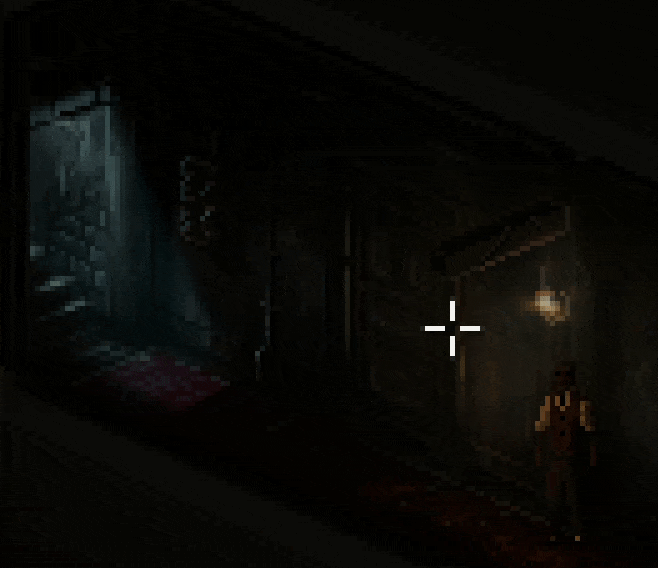
Lighting effects and subtle animations make even small scenes, like this brief encounter in a hallway, highly memorable. (Credit: Laura Hunt and Thomas Möhring. Fair use.)
There are small puzzles you have to solve to advance in the story, but none are likely to stump you for very long. That’s in part because there’s no inventory—you occasionally have to pick up an item, but you then immediately use it elsewhere in the scene. It’s point and click reduced to its essence.
With these simple mechanics, the game achieves surprising depth. For example, in the first story, you choose whether to interpret a telegram you have received from a lover positively or negatively. Depending on your choice, many subsequent interactions and observations will be different. In another story, you have to pay attention to sounds and voices instead of hunting for pixels.
Hunt and Möhring have made it clear that they do not want to be paid for the game, but they have suggested that an artbook and soundtrack may become available for purchase at a later date. If On A Winter’s Night, Four Travelers, then, is like a book you can pick up at any time from the library called the Internet. If you’re in the mood for a story that shows a little more darkness than light, I strongly encourage you to check it out.
Since the ascent of “casual” gaming, the explosion of online game publishing, and the rise of esports, video games have become mass culture for people of all ages. It’s only natural then to come across books like 1001 Video Games You Must Play Before You Die. The title a suggests grand curatorial ambition which the book never quite realizes.
It covers games across all devices and is organized chronologically, starting in 1971 (The Oregon Trail) and ending in 2013 (Bioshock Infinite). The book inexplicably focuses the bulk of its attention on titles from the 2000s (pages 416 to 921). So, prepare to read lots about the various Grand Theft Auto titles and Guitar Hero type games. On the other hand, Sierra Online’s entire catalog of adventure games is reduced to a single title (The Beast Within: A Gabriel Knight Mystery).
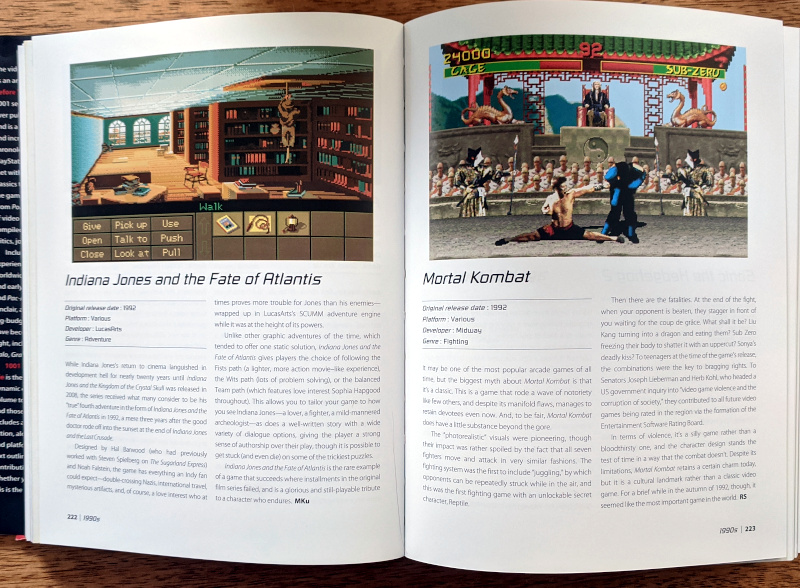
Most games in the book are as lavishly illustrated as the ones visible here. Some reviews, however, are entirely without screenshots. (Credit: Universe Publishing / Quintessence Editions Ltd. Fair use.)
The reviews of each title include plenty of criticism (sometimes so much that one has to wonder why the game made the cut at all), but no scores. With a large number of contributing writers, the quality of the writing is inconsistent. Some authors do an excellent job capturing a game’s ambience, story and gameplay; others barely describe the game at all, dwelling instead on development history and other minutiae.
My biggest frustration was that some games were included without any screenshots whatsoever—and we’re not talking about text adventures here, but titles like Elite or Nintendogs. This is the exception, but it’s still a cardinal sin for this kind of book, and the reason I can only give it three stars.
All in all, I don’t regret keeping this hefty compendium on my shelf, but if you’re looking for video game curation done well (with a lot more love for older games), I would recommend checking out the many titles by Bitmap Books instead.
So, what is your robot going to look like? Will it be a box with eyes on wheels, a flying furry puppet, a spider-robot with 360-degree vision? Make your selection and be presented with—another screen of text.
Choice of Robots is a game by Choice of Games, a company that should not exist. At least not if gaming followed the conventional history in which video game genres are forged in the fire of one generation of computing hardware, only to be wiped out in the avalanche of the next. Text adventures? They have gone the way of the dodo and the cathode-ray tube, surely.
Not quite. In 2009, Choice of Games released “Choice of the Dragon”, a text-based adventure game that became a smash success on mobile devices. Since then, they have released more than 100 titles under the “Choice of” label. The company has also made its game engine available under a license that permits noncommercial use, and they publish an endless flow of user-created titles.
It’s hard to explain the appeal of “Choice of” games if you haven’t played one. So go ahead, and try the damn dragon game in your browser. While the games share similarities with “Choose Your Own Adventure” gamebooks (“to attack the dragon, turn to page 69”), they offer a much larger number of choices, track internal variables, and do other things that computers can and books can’t. One thing they don’t do: trying to parse text input (“GET LAMP”). If you’ve ever played an old school text adventure, the parser is the one thing likely to drive you bonkers, because typing the exact words the computer expects can be a stochastic nightmare.

Just a few paragraphs of text, next choice. A bit more text, next choice. The formula works beautifully to get you to read a book without realizing it. (Credit: Choice of Games / Kevin Gold. Fair use.)
Robots then! Choice of Robots author Kevin Gold knows 01 thing or 10 about them. An Assistant Teaching Professor at Northeastern University, he “received his PhD from Yale University in 2008 for research on how robots could learn the meanings of pronouns and other abstract words from examples.” Choice of Robots isn’t about pronouns, though—it’s more about fulfilling that fantasy of “conquering Alaska with your robot army” that you’ve always had. OK, you also do get to pick your robot’s pronouns.
You start the game designing your robot and then walk down your chosen path, to achieve your destiny as a reclusive robot tinkerer or a power-mad corporate overlady. Yes, those are the only two options. Just kiddding.
The game beautifully adapts to your decisions. If you want your Alaska fantasy, that’s what you’ll get (hey, no judgment). If you want a love story, that’s what you’ll get. If you want a tale in which hyperintelligent robots become good-natured shepherds of their obsolete human builders, that’s probably also what you’ll get, but ask your robot supervisor.
Aside from the romantic options being fairly limited—this ain’t a robot dating sim—none of these paths feel underdeveloped. Gold’s writing draws upon the real world (let your professor introduce you to the military-industrial complex), on myths and legends (dress up as Hephaestus at a party), on literary references (quote The Tempest at a funeral), and much more. It does so while staying lighthearted and unpretentious, even as Gold’s PhD ever looms in the game’s byline.
Choice of Robots may make you think about what the future holds, but most of the philosophical ground it visits is well-traveled. It’s in the nature of the game to not be morally prescriptive. In other words, you can be clearly quite evil, if that’s how you want to play it. As an interactive story, it’s a masterclass that’s sure to keep you entertained for a few hours. To send your flying muppet into the world, it’s well worth the six bucks.
The Last Birdling is a visual novel by indie developer Marcus “InvertMouse” Lam released in 2017, two years after Cursed Sight (review). It tells the story of the secretive relationship between two girls, a human named Tayo and a birdling named Bimonia. The birdlings are winged humanoid creatures that once dominated the wild—but after a great war with the humans, Bimonia and her mother may be the last birdlings alive.

As a young woman, Tayo is drawn further into the conflict between birdlings and humans. (Credit: InvertMouse. Fair use.)
A a child, Tayo befriends Bimonia in the forest near a human settlement. For both girls, their growing friendship is a chance to escape their protective and demanding mothers, and to experience the joy of discovering the world through the eyes of another. But humans still view birdlings as dangerous monsters. If Bimonia is spotted by the townspeople, the result will almost certainly be bloodshed—and Tayo will be branded a traitor for becoming a birdling’s friend.
As the player, your perspective alternates between the two protagonists, and you are prompted to make many small choices. As Tayo, do you swallow a rotten herb offered to you by Bimonia, even though it may make you ill? The effect of these choices is limited until the end, when the nature of the relationship between Tayo and Bimonia leads to one of five endings.
Regardless of your decisions, this is not a cheerful tale. While the game is generally not visually explicit, it includes textual descriptions of violence, death, and sexual assault.
A well-crafted tale
Technologically, The Last Birdling is a solid title that showcases InvertMouse’s growing mastery over the visual novel format. The characters are visually expressive and the game is well-paced, offering beautiful chapter transition screens as the story progresses. As a player, it’s easy to visit the different endings without re-reading old text.
The game attempts a fair bit of worldbuilding, including a glossary that fleshes out concepts touched upon in the story. The quality of the writing is sometimes uneven, but never distractingly so. As in some of InvertMouse’s other stories, the characters do have a tendency towards self-loathing that gets a bit tiresome.
The Last Birdling is a better title than Cursed Sight in almost every respect, but in spite of that, I found it less emotionally impactful. The ambiguous relationship between Bimonia and Tayo pulled me away from the characters to the larger themes of the story. As a result, even the most tragic events packed less of a punch.
Nonetheless, The Last Birdling is a good story. I would recommend it to fans of the visual novel genre, if you’re in the mood for a fantasy tale about forbidden friendship that visits some dark places. At $5 it’s a small price for a labor of love by a storyteller of maturing talent.
Ein tolles Hotel in der Preisklasse. Innenstadtbereiche und doch sehr ruhig gelegen und mit der nahen U-Bahn nur einen Katzensprung vom Bahnhof Zoologischer Garten entfernt.
Mein Zimmer war frisch renoviert und mit allem ausgestattet, was für eine Übernachtung meiner Meinung nach erforderlich ist. Fernseher, Wasserkocher und reichlich Steckdosen auch mit separaten USB-Ports. Sehr schön gelungen ist die Einrichtung außerdem. Die Matratze ist angenehm hart und das Bett sehr breit. Sehr guter Schlaf ist garantiert.

Ansicht auf ein Bett in einem Zimmer im Hotel Carolinenhof in Berlin (Eigenes Werk. Lizenz: CC-BY-SA.)

Ansicht eines Badezimmers im Hotel Carolinenhof in Berlin (Eigenes Werk. Lizenz: CC-BY-SA.)
Das Frühstücksbüffet sucht in der Preisklasse seinesgleichen. Von Kurkumahonig, Walnuss-Karotten-Butter über frisches Brot und Brötchen bis hin zu einer großen Auswahl an Aufschnitt und Aufstrich ist alles vorhanden. Vieles kommt aus der Region oder ist fair gehandelt. Sehr vorbildlich. Zusätzlich kümmert sich das sehr freundliche Personal beinahe schon rührend um die Frühstücksgäste.
Warum es dennoch einen Stern Anzug gibt? Das Zimmer (201 in meinem Fall) war sehr hellhörig und die angrenzende Feuertür auf dem Flur war bei jedem Schließvorgang sehr deutlich zu hören. Schade, denn ein besser eingestellter Türschließer hätte die volle Wertung gebracht.

Ansicht eines Zimmers im Hotel Carolinenhof in Berlin (Eigenes Werk. Lizenz: CC-BY-SA.)
In Arrival of the Fittest (review), biologist Andreas Wagner made the compelling argument that life “finds its way” to solutions by way of neutral mutations. Through incremental changes, proteins can change shape gradually without losing their original function. As a population diversifies, natural selection can then identify those protein variants that have acquired entirely new, useful functions.
The book challenged a naive view of evolution, in which the vast majority of genetic mutations cause harm, and a small percentage of them confer an immediate survival benefit. The truth is that life needs to “play around” with neutral mutations to navigate the landscape of possible changes that may make a species more or less suited for survival.
In Life Finds a Way, Wagner applies this “landscape thinking” to all types of creative problem-solving. The first half of the book focuses on the concept of fitness landscapes, a limited but useful visual metaphor for how well-adapted specific genes (and the creatures they inhabit) are to their environment. The peaks in a three-dimensional landscape represent high levels of successful adaptation to the environment:
Visualization of a population of individuals evolving to become better suited for survival, i.e. “climbing a peak” in the fitness landscape. (Credit: Randy Olson and Bjørn Østman. License: CC-BY-SA.)
Natural selection marches steadily uphill. What prevents a population from being trapped on a small hill that represents an evolutionary dead end, an adaptation of limited usefulness that can’t be improved? Wagner breaks down how genetic drift (changes in frequency of specific gene variants), genetic recombination through sexual reproduction, and horizontal gene transfer in bacteria help individuals in a population slide or jump across the fitness landscape.
Wagner shows how potential energy landscapes in physics can similarly be used to map the possible configurations of molecules or crystals, and how gravity, thermodynamics and other physical forces push nonliving matter into stable (and often beautiful) configurations that represent valleys in the landscape.
Of mountains and molehills
In the second half of the book, Wagner applies landscape thinking to human creativity. He encourages us to visualize the map of creative solutions to a given problem (even if that “problem” is the composition of beautiful music) as a landscape with peaks and valleys. What does it take for a creative mind to climb mountains and avoid getting stuck on molehills of mediocrity?
The author enumerates many tools creative minds can use to traverse the landscape of ideas without getting stuck, including:
-
dreams
-
play
-
travel and exposure to other cultures
-
work with people from other disciplines
-
drugs.
As a positive model for cross-disciplinary work, Wagner cites the Santa Fe Institute, a renowned cross-disciplinary think tank where Wagner is an External Professor. (One way I hope they won’t be a model: even though the institute was only founded in 1984, its seven founders were all men, something Wagner does not remark upon.)
Into the badlands
Wagner harshly criticizes the obsession with standardized testing in the United States, and the rigid education approaches of South Korea and China. In his critique, he revisits familiar generalizations about “Western” and “Eastern” cultures, and seems to see “Eastern” cultures trapped in rigid uniformity, while situating the pinnacle of individual freedom in the United States.
Nations that want to nurture creative minds, Wagner argues, should reduce the negative consequences of failure—whether it’s for scientists applying for a research grant, or for entrepreneurs starting a business. Creative societies should be accessible to immigrants with diverse backgrounds, and recognize the benefits of diversity and individual freedom.
While Wagner pays lip service to the dangers of inequality, his analysis is stuck in a neoliberal frame of reference. Much more could be written about how an effective welfare state, a vibrant democracy, and alternatives to exploitative capitalism and intellectual monopoly rights (copyright, patents, etc.) are necessary to reap the benefits of human creativity for all people.
Instead, Wagner repeatedly cites Silicon Valley as an example for innovation, with the implicit assumption that the way to make a better world is to create more corporations like Facebook, Apple, and Tesla.
It’s worth remarking that Life Finds a Way was written before the COVID-19 crisis laid bare the utter incompetence of many “Western” governments, including the United States, in managing a pandemic. The landscape of ideas about COVID-19 is dotted with the creative edifices built by anti-vaxxers and ideologues, and landscape thinking alone seems like a very limited tool for getting humanity out of the badlands.
Thankfully, Wagner’s flurry of societal prescriptions is as brief as it is unimaginative. What we’re left with, then, is his argument to apply landscape thinking beyond physics and biology, providing an intellectual foundation for the value of letting our minds roam. That’s all it is—a foundation, one which I do hope other writers will build on.
Das Vegs ist die einzige komplett vegane Gastronomie in Halle. Es gibt ein breites Angebot an Wraps, Burgern, Fladenbroten und weiteren Speisen.
Es gibt innen ein paar Plätze und bei schönem Wetter kann man sich draußen hinsetzen. Die Atmosphäre entspricht einem Fast-Food-Bistro.
Da es mir gut schmeckt, bin ich regelmäßig dort.
Damn the Vek! Too stupid to communicate with, but smart enough to seek out human civilization wherever it is. In every timeline, the plague of giant insect monsters is close to wiping out what’s left of humanity. They breed underground and tunnel their way to the surface, only to bring death and devastation.
Insecticide won’t kill these bugs dead, but a squad of piloted battle mechs might. Or might not. Fortunately for the multiverse, humanity has learned how to travel between parallel universes, to attempt to rescue as many timelines as possible from the Vek.
Once more Into the Breach then, with another squad! Released in 2018, the second title by Subset Games after FTL cemented the tiny indie studio’s reputation for excellence. It takes plenty of inspiration from legendary turn-based strategy games (Advance Wars especially comes to mind), but still feels fresh and unique.
Much of this is due to the tightness of gameplay and mechanics. Assemble your team. Click. Pick a scenario. Click click. And: you’re in the fight. The map fits on one screen. You place your units. The enemy moves. The enemy starts to attack—and now it’s your turn.
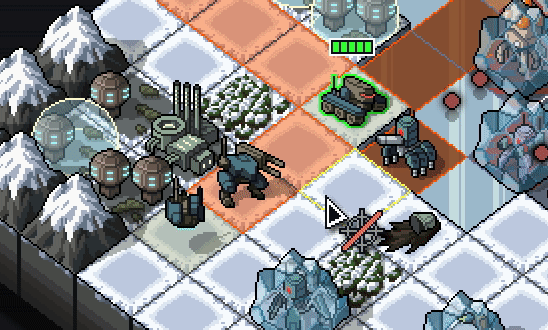
A member of the Zenith Guard, a charge mech, finds its target. (Credit: Subset Games. Fair use.)
Depending on your squad and each mech’s buildout, you can destroy units, push and pull them, create hazards, create shields, and more. The array of skills turns every round into a small puzzle. How will you prevent the enemy from damaging your units, or killing civilians in a building, or destroying strategic targets?
Miscalculate, and the Vek might end up taking down the energy grid—game over. It’s permadeath, sort of: you can take one of your pilots to the next timeline. Too bad for this one.
An Honest Roguelike
From a limited number of ingredients, the game cooks up a fresh set of scenarios for you on each run. Some maps are especially difficult to beat without taking some hits to buildings; any damage you take to the energy grid carries over to the next map. You have to make some strategic choices between battles—which battles to fight, which upgrades to install—but most of the game is tactics, tactics, tactics.
The difficulty level is not quite as punishing as that of FTL or other roguelikes that celebrate starting over as part of the fun. At normal difficulty, you may notch your first game victory after a few runs, perhaps even on the first try. The Vek are as stupid as they are relentless. But the game will produce enough brain twisters to keep you coming back.
When you manage to shove a nasty Vek into the sea, or cause a chain reaction of monsters killing each other, it’s quite the payoff. If that isn’t enough, the game rewards you with unlockable squads, experience points, upgrades, and ambient dialogue that never gets in the way.
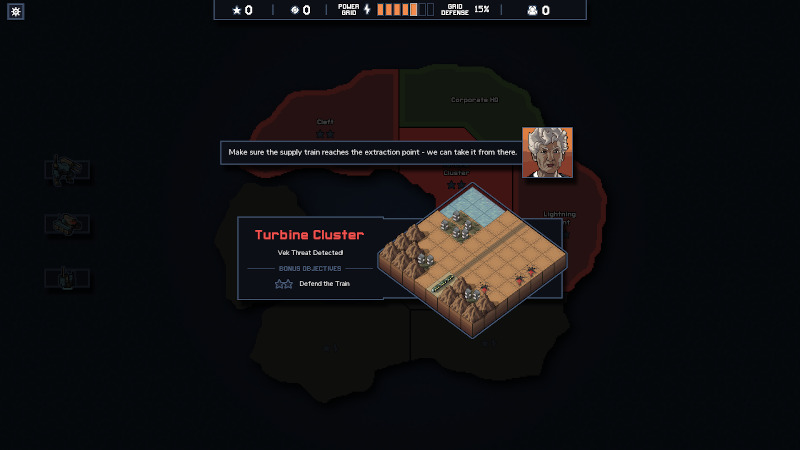
Mission briefings are terse, but there’s a large enough variety of objectives to keep things interesting. (Credit: Subset Games. Fair use.)
The Verdict
While it’s a very different game than FTL, it’s clearly built with the same design philosophy. The pixel art is more beautiful than FTL’s, but never extravagant; the UI provides help when it needs to and otherwise gets out of the way; moving your units feels as straightforward as moving the pieces on a chessboard.
In spite of the absurd premise and cartoonish physics (units can be encased in ice and unfrozen without damage), the game’s tone is mostly somber; even victory is just a brief reprieve in an endless war played out across universes. The fun is in solving the puzzles the random number generator throws at you and kicking some serious Vek butt. If that kind of turn-based strategy sounds like your cup of tea, you can’t go wrong heading Into the Breach.
Klein aber fein ist dieses Hotel im Zentrum Heidelbergs. Vom Hauptbahnhof sowohl zu Fuß als auch mit öffentlichen Verkehrsmitteln sehr gut zu erreichen und daher auch eine ideale Ausgangslage für Aktivitäten in der Stadt.

Aussenansicht des Hotels Tannhäuser in Heidelberg (Eigenes Werk. Lizenz: CC-BY-SA.)
Das es kein durchdesigntes Hotel einer ausstauschbaten Kette ist merkt man schon beim Betreten des Hauses und auch die Zimmer machen einen sehr guten Eindruck. Wenn das Standardzimmmer hier schon größer ist als anderswo eine Suite dann freue ich mich darüber.

Ansicht eines Zimmers im Hotel Tannhäuser in Heidelberg (Eigenes Werk. Lizenz: CC-BY-SA.)

Ansicht eines Zimmers im Hotel Tannhäuser in Heidelberg (Eigenes Werk. Lizenz: CC-BY-SA.)
Das Frühstücksbüffet bietet alles, wirklich alles, was ich in dieser Kategorie erwarte. Keine abgepackten Marmeladen, Discountersalami oder Aufbackbrötchen. Alles ist frisch und - auch noch um 9:30 Uhr - reichlich vorhanden. Im Hintergrund läuft leise Musik und man kann gemütlich und satt in den Tag starten.

Frühstücksbuffet im Hotel Tannhäuser in Heidelberg (Eigenes Werk. Lizenz: CC-BY-SA.)
Einziger Wermutstropfen ist der bereits oben erwähnte Nahverkehr. Die Straßenbahn hat direkt vor dem Hotel mehrere Kurven und Weichen zu passieren. Mit Ohrenstöpseln aber kein Problem.
Cursed Sight is a visual novel developed by Marcus “InvertMouse” Lam, an Australia-based indie developer. We meet the protagonist, Gai, at the age of 10 when he is sold by his parents to work as a servant for the king of East Taria, a fictional Asian kingdom. Gai becomes responsible for helping to protect the kingdom’s “treasure”—a young girl named Miyon born with dangerous abilities that King Lok is exploiting.
As the story progresses, Gai develops a friendship with Miyon and her caretaker, a young woman named Sasa. As Gai and Miyon grow older, they consider what kind of life may be possible beyond the captivity of the temple. Their decisions could cost them their lives, and they will certainly shape the future of the kingdom.
This is a mostly kinetic visual novel, meaning that you read it by clicking through it. There are 4 different endings, which you access through a couple of branch-points in the story where you do get to make choices.
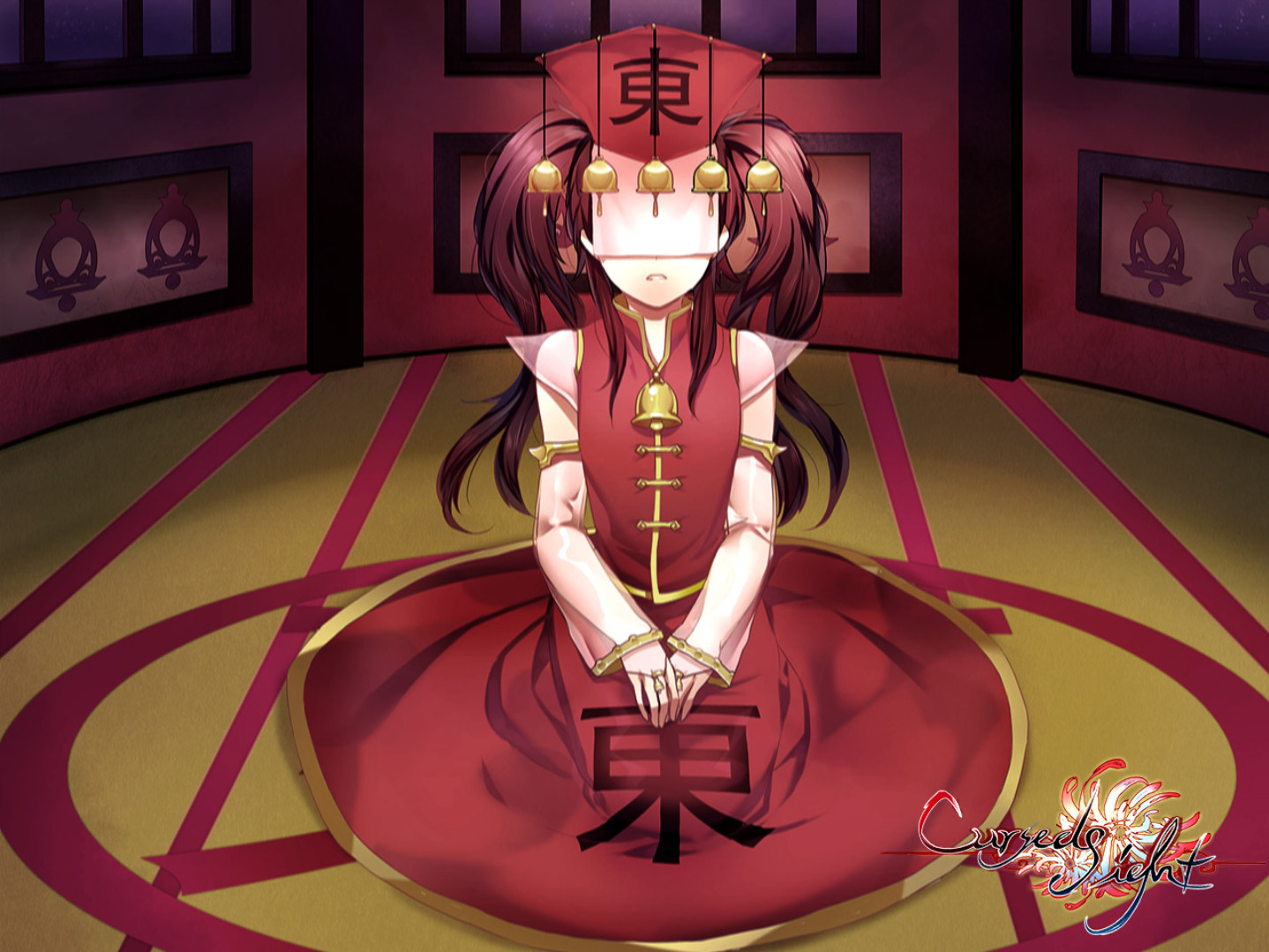
Miyon is a young girl who is held captive to exploit the mysterious power of her cursed sight. Beautiful screens like this one are used as segways between different chapters of the story. (Credit: InvertMouse. Fair use.)
The art is lovely, and the music, while repetitive, fits the setting. The story is not voiced. The writing is decidedly mixed. Gai never quite acts his age (his 10-year-old version is too adult, his adult version is too childish); some paragraphs really needed an editor; anachronistic references and expressions distract from the setting. The most cringeworthy example is this one:
Miyon had opened up so much that I worried the other servants, or even guards, might become interested in her. I would fight them all in a cage at the same time if they dared touch her. Well, maybe after I attached a chainsaw to my left arm.
(Yes, that’s a reference to a chainsaw in a game that is meant to be set in the distant past.)
The game is at its strongest when it conveys emotions and builds its characters. I certainly became invested enough to finish the story and to get to all four endings, and the story moved me to tears a couple of times. While the game is only of average quality overall, there’s the kernel of something lovely here, and I look forward to playing more of InvertMouse’s games in the future.
